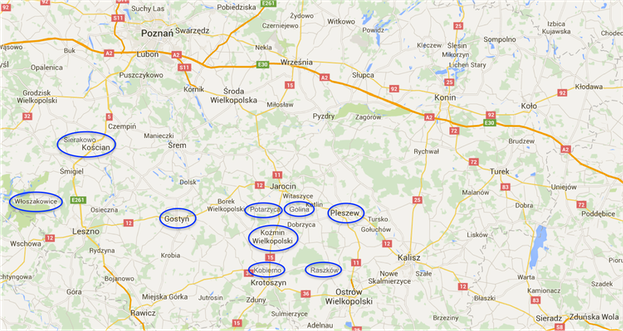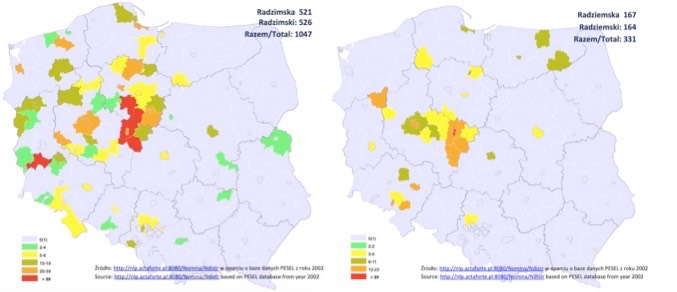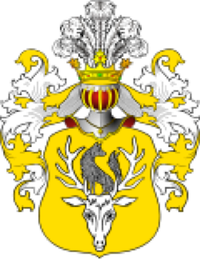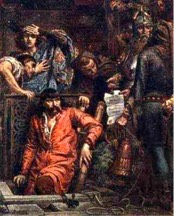_________________________________________________________________________________________________________
Short story about the origin of the family names: Radzimski and Radziemski
by
Zbigniew Radzimski and Leon Radziemski
I. Abstract
This is a story about the origin of the Radzimski/Radziemski family lineage. According to historical documents it starts with Maćko Borkowic, General of Wielkopolska who lived in Poland in XIV century. We start with a short history of Poland around this time, life of Maćko Borkowic, and his inheritance that starts the Radzimski lineage. At the present time, it is difficult to make a direct forward connection with any person living today. Actual records allow us to trace the lineage backwards from the present day surnames to about 1760. We note that there were at least two common spellings of surnames in this lineage, Radzimski and Radziemski, and several others with slightly different spellings used less frequently. For simplicity and because, for the most part, Radzimski was the surname actually used in Poland, in this article we only use Radzimski unless individuals we cite actually had differently spelled surnames. Full version of this story recently published in Rodziny, Journal of the Polish Genealogical Society of America:
II. Early History of Poland
Our story can be traced to times of Władysław I Łokietek (the Elbow-high) who was crowned king of Poland on January 20, 1320. The coronation took place in Cracow that became his capital city, and the place where all kings of Poland were crowned and buried. The successor to the son of king Władysław, was Kazimierz III Wielki (the Great) (1333-1370) who presided over a period of peace and prosperity in Poland.
The growth of towns, advances in learning (linked with the founding of a university in Cracow in 1364) and the provision of public buildings all testify to the wise patronage of Kazimierz. Another was his wise but unconventional decision to welcome to Poland the Jews displaced by persecution elsewhere after the horrors of the Black Death. Kazimierz Wielki was the last Polish king from the Piast dynasty.
It is during the reign of these two kings (Władysław I Łokietek and Kazimierz the Great) that we hear about Maciej (Maćko) Borkowic coat of arms Napiwoń, a general from Wielkopolska. According to several sources he should be considered as a starting point of the lineage of the Radzimski’s family. More information on this subject can be found in Chapter III.
III. Origin of Polish names
The most popular last names in Poland, often called typical Polish names, are those that end with –ski or –cki. The examples would be Kowalski (131940), Wiśniewski (104418), Orzechowski (15656), Szymański (84527), Wróblewski (36435), Czarnecki (32525). The numbers in parenthesis list the number of Polish citizens with those names living in Poland in 1990. (This information was obtained from WEB site moikrewni.pl.) These types of names appeared first in XIV century and gained popularity in the middle of XV century. Typically such names originated from the names of places or villages that were owned by these people, later they were also used by people who lived in these places. As the names became more popular, they were not necessarily inherited. Therefore, especially among noble people, brothers could have different names since they inherited different villages or towns. The noble people with the same –ski name didn’t have to be related since the villages were often sold, exchanged or lost/won in gambling. Each new owner could use the village name as his surname. A classical case would be that of the inheritance of General Borek.
IV. Maćko Borkowic
The life of Maćko Borkowic, General of Wielkopolska is relatively well documented in Polish history. He is related to Wojsław Borek Borkowic from West Pomerania, coat of arms Napiwoń, who settled in Wielkopolska in Sierakowo near Kościan. His descendants became very influential in this region. It was then his son Borek known since 1279 who had three sons Przybysław Borkowic, Voivode of Poland, Andrzej Borkowic, Castellan of Kalisz, and Wojsław from Gryżyna, judge in Poznań, (1310-1353). 3)
Przybysław Borkowic from Sierakowo, son of Borek, became Elder (Starosta) of Poznań during period of 1319 to 1324 and helped Władysław Łokietek in his struggles with Knights of the Cross who occupied the northeastern part of Poland, and Czechs who claimed territorial rights to the Southern part of Poland (current Lower Silesia). More trouble came from the Czechs and their King Jan Lucemburský (John the Blind) who kept alliances with the Knights. It was most likely in mid 1320 when the Knights entered Polish territory again, this time the invasion was coordinated with Lucemburský. The Knights’ and Czech’s armies were supposed to meet near town of Kalisz and attack it together. According to “Herbarz Polski” by Kasper Niesiecki (edited by Jan Bobrowicz (vol VIII), published by Breitkopf and Baertel in Lipsk, 1841): “Fryczko Borek, a general from Wielkopolska, gathered people from Kościan county and Wschowa’s area and pushed back the Czechs which allowed the defeat of the Knights. Recognizing this effort of defending Wielkopolska, King Władysław Łokietek awarded General Borek with the city of Gostyń and 40 villages, among them Koźmin, Pleszew, Raszków, Potaszyce and Radzymie.” We believe that the “General Borek” mentioned in the previous quote was Przybysław Borkowic who is referred in this story as Fryczko Borek. Przybysław died on August 4, 1328, leaving behind two sons Maćko and Borek from Grodzisk, both inheriting the coat of arms Napiwoń. A more detailed discussion of the connection between names and villages is found in Section V.
Maćko Borkowic, son of Przybysław, played important political and military role in the in the history of Poland. In 1340 Maćko Borkowic led knights of Wielkopolska in the military excursion to Ruś. He became the Governor of the Poznań territories in 1343. In 1348 Kazimierz the Great, pressed by noble families of Wielkopolska, withdrew the position of the Lord of Wielkopolska and replaced it with two posts, one the Lord of Poznań that was headed by Maćko and the second Lord of the Kalisz territories. This move led to some skirmishes and king Kazimierz dissolved these two positions and re-established the single position and named Wierzbięta from Paniewic (Silesia) as the Lord of Wielkopolska. The nomination created a revolt among nobles of Wielkopolska. This led to the formation of the confederation in 1352 with Maćko being their leader. King Kazimierz defeated this revolt and Maćko swore a loyalty oath to Kazimierz in Sieradz on February 16, 1358. During this oath, for the first time in the history of Poland, the word Republic (Respublica in Latin) was used.
Maćko was not completely loyal to the king and in 1360 he was arrested in Kalisz and sentenced by the king to death by starvation. He was imprisoned in the Olsztyn castle near Czestochowa where he died on February 9, 1360. This event was a theme for a painting by one of the most famous Polish painters, Jan Matejko, in 1873.
V. Origin of Radzimski’s lineage and Coat of Arms Napiwoń
As mentioned in the historical brief above both Przybysław and his son Maćko helped in many ways King Władysław Łokietek and his son Kazimierz the Great in their fights for Polish territories. They were rewarded with land and villages for this help. There are several references in the records about this recognition. For example we can find in Herbarz Polski of Kasper Niesiecki that “The family of Przybysław received from king Łokietek city of Koźmin and 15 adjacent villages as a reward for wining over in 1324 Castles of Zbąszyń, Kopanica and Przyprostynia from Prince of Głogów.”
The story described in Ref. 4 an 5 brings us closer to Radzimski’s name. The story of Fryczko Borek, mentioned in the previous chapter, tells us also that it was Marcin Borek Gostyński, heir of Gostyń and Włoszakowice who had three sons, Maciej, Stanisław and Marcin, with heiress Suchorzewska of Pleszewie and Radzim. Maciej inherited Pleszów, Raszków, Poturzyce and Radzym, from which Borek family took name Radzimski. Stanisław received Włoszakowice with 15 villages and Marcin received Gostyń with 14 villages.
A similar story can be found in “The collection of Count Seweryn Uruski” 6): “They (Radzimskis) are related to the very old and noble family from Pomorze, Borek. Their ancestor is Fryczko Borek, a general from Wielkopolska, who was given the city of Gostyń with 40 villages by Polish king Władysław Lokietek for his help in getting rid of the Czechs from Wielkopolska and maintaining him on the throne of Poland. Families of Gostyński, Borkowicz and Radzimski are initiated from this Fryderyk Borek. The Radzimski’s family took their name from Radzim that was given to them as a part of this award …”
We believe that the inheritance story starts with Przybysław who passed the properties to Maćko. Strong evidence here is the fact that it was king Kazimierz the Great who confirmed that Koźmin belonged to Maćko who inherited it from his father Przybysław. However, it is difficult to define the connection between Maćko and Marcin Borek Gostyński. Despite this gap, one can assume that multiple references to Radzimski’s name in Borek’s family story and the sharing of the same coat of arms Napiwoń, place the origin of Radzimski’s name around late XIV century.
Summarizing the records that we were able to identify so far, here are the towns and villages in Wielkopolska that can be traced to Borek’s family:
• Sierakowo: most likely place of Maćko’s birth, his father Przybysław Borkowic was from Sierakowo near Kościan.
• Gostyń, Pleszew, Raszków, Potarzyca, Włoszakowice, Radzim granted to Przybyslaw by king Władysław I Łokietek in 1331.
• Golina, Koźmin, Kobierno places granted in 1338 to Maćko by king Kazimierz the Great. Koźmin was actually given earlier to Przybysław but Kazimierz the Great confirmed the ownership to Borek’s family.

Wielkopolska Region where most of the places associated with Borek’s family can be found.
It is important to remember that the main connection between generations in the earlier history of Poland was not through the last name but through a coat of arms. As mentioned earlier Borek Borkowic inherited his coat of arms Napiwoń, from his ancestors in Pomerania. Following the tradition the coat of arms was passed on to all descendants of Borek including Przybysław, Maćko and his relatives. That is why it is understandable to find the following story in the Almanac of Polish Coats of Arms, written by Zbigniew Leszczyc), published in Poznan, Poland in 1908 Volume 1, Pg. 273.: “The Coat of Arms called Napiwoń belonged to the following families, from Wielkopolska: Borkowicz from 1250, Gostyński from 1500, Ossowski from 1700, Radzimski from 1480, Włoszakowski from 1440.” Borek Borkowic mentioned in this text would be the first Borek who started his family trail in Wielkopolska. According to Ref. #8 these are additional families that used the Napiwoń coat of arms: Bortkiewicz, Cierpiński, Jutrowski, Napiwoński, Nargiałowicz, Nargiałło, Nejman. Most of these names originate from the names of settlements that Borek’s family inherited.
The most referenced of several versions of the Napiwoń is shown in Figure 2 below, however there are also earlier references to the image showing two wolves, one on top of each other.
The name Napiwoń of the coat of arms originates from a very common call “Na piwo” that translates to “buy yourself a beer”. [a translation of the words “Na piwo” can be broken down into NA meaning for, and PIWO meaning beer]. One can find an anecdote in literature stating that Borek was hunting with the King of Poland, and saved the king from a tragic death. The King in return, took out some gold coins from pocket and said, general, please accept this money to drink to my health. Beer was a very popular drink at the time, so one could say that the General received money “Na piwo”. Various authors have repeated the story but its origin cannot be traced to a specific source.
VI. Where is Radzim?
Considering the above story about Borek’s family and its interesting connection with the origin of the Radzimski’s name, it is obviously useful to try to identify the place Radzim that was passed on to one of the sons of Maćko Borkowic. Searching through historical documents one can find many places that existed or in some cases still exist in Poland with the name Radzim or other similar names, such as for example Radzimie, Radzym, Radzimin, Radzyn. In our story we should focus of course on places situated in Wielkopolska, home of Borek’s family. If we take into consideration all the places associated with Borek’s family records from XIII and XIV century we are talking about the search area of about 500 square miles extending from Włoszakowice on the West to Pleszew on the East and Raszków on the South and Grodzisk on the North. In this area the following places can be identified according to Geographical Dictionary of Poland and other Slavic Counties:
1. Radzynie (sometimes called Radzim) near Pleszew with the last owner listed in 1506 as count Mikolaj from Raciborz. This place doesn’t exist anymore.
2. Radzimia, a settlement with a watermill on the Pokrzywnica river in Konin county, parish church in Rychwał, of the Dabroszyn community. Today Radzimia does not exist under this name; it is incorporated in Wola Rychwalska village. (Page #472)
3. Radzyń in parish Rdutów near Kutno. There is a record stating that in 1576 the village had four owners with the last name Radzyński and first names Marcin, Jakub, Stanisław and Anna. (Page #483)
4. Rybno Wielkie Near Gniezno that was called before the XVth century Radzimińskie, Radzimskie and Rybno Radzim. In the XVIIth century the Radzimiński family is listed as landlord of this place.
5. Radzyń near Szamotuły, in old days called Radzyny (Page #483)
6. Radzimin in Szubin County near Kcynia. This place belonged to the Radzimiński’s family until at least 1845.
7. Radzim near Oborniki in Poznan district. This place is well documented since 1236 when the first church was built. In 1256 there is a first record about a castellany and its castle. The first castellan was Beniamin (coat of arms Zaremba) and it looks like the castellany lasted until 1425. While there is nothing in the records about General Borek, it is interesting that in 1360 King Casimir as a part of a territory exchange transferred Radzim to the Malta Order. This was the year when General Borek was sentenced to death by this king. Today this Radzim doesn’t exist anymore. (Page #471 and 472).
8. Radzyń Chełmiński; it is mentioned by Dlugosz in 1278 as Radzim and Radziń. First records on this town can be traced to 1224.
Considering the following record: “Maciej the oldest one received Pleszew, Raszków, Potarzyca with 12 villages, with Radzimie among them”, the search area that Maciej inherited from Maćko would cover the roughly 80 square miles. In this area the most likely places on the list above would be #1 - Radzim near Pleszew, #2 - Radzimia near Rychwal or #3 – Radzyń near Rdutów. Interestingly, the highest concentration of people in Poland with the name Radzimski or its derivatives live currently in this region.
VII. Radzimskis and Radziemskis in Poland today
According to the web site “Moi krewni” (My relatives) 10) there are 1047 people with the last name of Radzimski and Radzimska and 331 people with names Radziemski and Radziemska living in Poland now, see map below. There are also 823 people with the name Radziński or Radzińska and 419 people with the name Radzimiński or Radzimińska. The numbers are based on the 2002 census.

Map of Poland showing counties with highest population of people
with names Radzimski, Radzimska, Radziemski and Radziemska
The highest population of 152 people is in County Konin, next is Turek with 100 people and then Radziejów with 69 people. These three counties are situated next to each other in Wielkopolska. We can see that this region of Poland has the most significant portion of Radzimskis. As earlier shown, this is the place to which Maćko Borkowic and his descendants can be traced.
As far as we know no current Radzimski person can be directly traced to Maćko. We are aware of several lineages that are going back to period from ~1750 to 1800 (see "Find People page).
At this stage of our research, the lineage of the Radzimski’s and Radziemski branches of Borek’s genealogical tree ends. Further studies are required. We hope this paper will be of use to the many persons with the family name of Radzimski and Radziemski who live currently, not only in Poland, but also in the United States and other countries.
VIII. References
1. WEB site: History World: Poland: http://www.historyworld.net/wrldhis/PlainTextHistories.asp?historyid=ab01
2. Henryk Szumielski – Nazwiska. WEB Site: http://szukajprzodka.pl/n4.php
3. WEB Site: Castles of Poland: http://www.ruinyizamki.pl/poczet-sobiepanow/borkowic1.htm
4. “Herbarz Polski” by Kasper Niesiecki, edited by Jan Bobrowicz (vol VIII), published by Breitkopf and Baertel in Lipsk, 1841.
5. “Tomasza Święckiego Historyczne pamiątki znamienitych rodzin i osób dawnej Polski” Volume 2, Publisher Warsaw: Wydawn. Artystyczne i Filmowe, Year 1859
6. “The collection of Count Seweryn Uruski with the help of Adam Amilkar Kosinski, edited by Aleksander Wlodarski. Gebethner and Wolf issued the book in Warsaw in 1904. (Vol. XV, page 141)”:
7. Zbigniew Leszczyc, “Almanac of Polish Coats of Arms”, published in Poznan, Poland in 1908
8. WEB Site: Polish Genealogy: Collection of Polish Coat of Arms: (http://www.genealogia.okiem.pl/)
9. Web site: Geographical Dictionary of Poland and other Slavic Counties:
http://dir.icm.edu.pl/pl/?find_in=fulltext&volume_id=1&find_text=radzim&search_volume=all&x=37&y=5
10. WEB site showing the residence of Polish citizens by their last name: http://www.moikrewni.pl/mapa/
11. WEB site: Genealogia Rodziny Radzimskich: http://drzewo-radzimskich.ugu.pl/index.html

